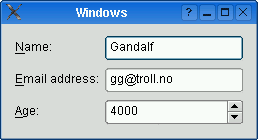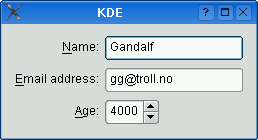QFormLayout¶
The
QFormLayoutclass manages forms of input widgets and their associated labels. More…

Synopsis¶
Functions¶
def
addRow(label, field)def
addRow(label, field)def
addRow(labelText, field)def
addRow(labelText, field)def
addRow(layout)def
addRow(widget)def
fieldGrowthPolicy()def
formAlignment()def
getItemPosition(index)def
getLayoutPosition(layout)def
getWidgetPosition(widget)def
horizontalSpacing()def
insertRow(row, label, field)def
insertRow(row, label, field)def
insertRow(row, labelText, field)def
insertRow(row, labelText, field)def
insertRow(row, layout)def
insertRow(row, widget)def
itemAt(row, role)def
labelAlignment()def
labelForField(field)def
labelForField(field)def
removeRow(layout)def
removeRow(row)def
removeRow(widget)def
rowCount()def
rowWrapPolicy()def
setFieldGrowthPolicy(policy)def
setFormAlignment(alignment)def
setHorizontalSpacing(spacing)def
setItem(row, role, item)def
setLabelAlignment(alignment)def
setLayout(row, role, layout)def
setRowWrapPolicy(policy)def
setVerticalSpacing(spacing)def
setWidget(row, role, widget)def
verticalSpacing()
Detailed Description¶
QFormLayoutis a convenience layout class that lays out its children in a two-column form. The left column consists of labels and the right column consists of “field” widgets (line editors, spin boxes, etc.).Traditionally, such two-column form layouts were achieved using
QGridLayout.QFormLayoutis a higher-level alternative that provides the following advantages:
Adherence to the different platform’s look and feel guidelines.
For example, the macOS Aqua and KDE guidelines specify that the labels should be right-aligned, whereas Windows and GNOME applications normally use left-alignment.
Support for wrapping long rows.
For devices with small displays,
QFormLayoutcan be set towrap long rows, or even towrap all rows.Convenient API for creating label–field pairs.
The
addRow()overload that takes aQStringand aQWidget* creates aQLabelbehind the scenes and automatically set up its buddy. We can then write code like this:formLayout = QFormLayout() formLayout.addRow(self.tr("&Name:"), nameLineEdit) formLayout.addRow(self.tr("&Email:"), emailLineEdit) formLayout.addRow(self.tr("&Age:"), ageSpinBox) setLayout(formLayout)Compare this with the following code, written using
QGridLayout:nameLabel = QLabel(self.tr("&Name:")) nameLabel.setBuddy(nameLineEdit) emailLabel = QLabel(self.tr("&Name:")) emailLabel.setBuddy(emailLineEdit) ageLabel = QLabel(self.tr("&Name:")) ageLabel.setBuddy(ageSpinBox) gridLayout = QGridLayout() gridLayout.addWidget(nameLabel, 0, 0) gridLayout.addWidget(nameLineEdit, 0, 1) gridLayout.addWidget(emailLabel, 1, 0) gridLayout.addWidget(emailLineEdit, 1, 1) gridLayout.addWidget(ageLabel, 2, 0) gridLayout.addWidget(ageSpinBox, 2, 1) setLayout(gridLayout)The table below shows the default appearance in different styles.
QCommonStylederived styles (except QPlastiqueStyle)QMacStyle
QPlastiqueStyle
Qt Extended styles
Traditional style used for Windows, GNOME, and earlier versions of KDE. Labels are left aligned, and expanding fields grow to fill the available space. (This normally corresponds to what we would get using a two-column
QGridLayout.)Style based on the macOS Aqua guidelines. Labels are right-aligned, the fields don’t grow beyond their size hint, and the form is horizontally centered.
Recommended style for KDE applications. Similar to MacStyle, except that the form is left-aligned and all fields grow to fill the available space.
Default style for Qt Extended styles. Labels are right-aligned, expanding fields grow to fill the available space, and row wrapping is enabled for long lines.
The form styles can be also be overridden individually by calling
setLabelAlignment(),setFormAlignment(),setFieldGrowthPolicy(), andsetRowWrapPolicy(). For example, to simulate the form layout appearance of QMacStyle on all platforms, but with left-aligned labels, you could write:formLayout.trowWrapPolicy(QFormLayout.DontWrapRows) formLayout.setFieldGrowthPolicy(QFormLayout.FieldsStayAtSizeHint) formLayout.setFormAlignment(Qt.AlignHCenter | Qt.AlignTop) formLayout.setLabelAlignment(Qt.AlignLeft)See also
-
class
QFormLayout([parent=None])¶ - param parent
Constructs a new form layout with the given
parentwidget.See also
-
PySide2.QtWidgets.QFormLayout.FieldGrowthPolicy¶ This enum specifies the different policies that can be used to control the way in which the form’s fields grow.
Constant
Description
QFormLayout.FieldsStayAtSizeHint
The fields never grow beyond their
effective size hint. This is the default for QMacStyle.QFormLayout.ExpandingFieldsGrow
Fields with an horizontal
size policyofExpandingorMinimumExpandingwill grow to fill the available space. The other fields will not grow beyond their effective size hint. This is the default policy for Plastique.QFormLayout.AllNonFixedFieldsGrow
All fields with a size policy that allows them to grow will grow to fill the available space. This is the default policy for most styles.
See also
-
PySide2.QtWidgets.QFormLayout.RowWrapPolicy¶ This enum specifies the different policies that can be used to control the way in which the form’s rows wrap.
Constant
Description
QFormLayout.DontWrapRows
Fields are always laid out next to their label. This is the default policy for all styles except Qt Extended styles.
QFormLayout.WrapLongRows
Labels are given enough horizontal space to fit the widest label, and the rest of the space is given to the fields. If the minimum size of a field pair is wider than the available space, the field is wrapped to the next line. This is the default policy for Qt Extended styles.
QFormLayout.WrapAllRows
Fields are always laid out below their label.
See also
-
PySide2.QtWidgets.QFormLayout.ItemRole¶ This enum specifies the types of widgets (or other layout items) that may appear in a row.
Constant
Description
QFormLayout.LabelRole
A label widget.
QFormLayout.FieldRole
A field widget.
QFormLayout.SpanningRole
A widget that spans label and field columns.
See also
-
PySide2.QtWidgets.QFormLayout.addRow(layout)¶ - Parameters
layout –
QLayout
This is an overloaded function.
Adds the specified
layoutat the end of this form layout. Thelayoutspans both columns.
-
PySide2.QtWidgets.QFormLayout.addRow(label, field) -
This is an overloaded function.
-
PySide2.QtWidgets.QFormLayout.addRow(label, field) -
Adds a new row to the bottom of this form layout, with the given
labelandfield.See also
-
PySide2.QtWidgets.QFormLayout.addRow(widget) - Parameters
widget –
QWidget
This is an overloaded function.
Adds the specified
widgetat the end of this form layout. Thewidgetspans both columns.
-
PySide2.QtWidgets.QFormLayout.addRow(labelText, field) - Parameters
labelText – unicode
field –
QLayout
-
PySide2.QtWidgets.QFormLayout.addRow(labelText, field) - Parameters
labelText – unicode
field –
QWidget
-
PySide2.QtWidgets.QFormLayout.fieldGrowthPolicy()¶ - Return type
See also
-
PySide2.QtWidgets.QFormLayout.formAlignment()¶ - Return type
Alignment
See also
-
PySide2.QtWidgets.QFormLayout.getItemPosition(index)¶ - Parameters
index –
int
Retrieves the row and role (column) of the item at the specified
index. Ifindexis out of bounds, *``rowPtr`` is set to -1; otherwise the row is stored in *``rowPtr`` and the role is stored in *``rolePtr`` .See also
-
PySide2.QtWidgets.QFormLayout.getLayoutPosition(layout)¶ - Parameters
layout –
QLayout
Retrieves the row and role (column) of the specified child
layout. Iflayoutis not in the form layout, *``rowPtr`` is set to -1; otherwise the row is stored in *``rowPtr`` and the role is stored in *``rolePtr`` .
-
PySide2.QtWidgets.QFormLayout.getWidgetPosition(widget)¶ - Parameters
widget –
QWidget
Retrieves the row and role (column) of the specified
widgetin the layout. Ifwidgetis not in the layout, *``rowPtr`` is set to -1; otherwise the row is stored in *``rowPtr`` and the role is stored in *``rolePtr`` .See also
-
PySide2.QtWidgets.QFormLayout.horizontalSpacing()¶ - Return type
int
See also
-
PySide2.QtWidgets.QFormLayout.insertRow(row, label, field)¶ -
Inserts a new row at position
rowin this form layout, with the givenlabelandfield. Ifrowis out of bounds, the new row is added at the end.See also
-
PySide2.QtWidgets.QFormLayout.insertRow(row, labelText, field) - Parameters
row –
intlabelText – unicode
field –
QWidget
-
PySide2.QtWidgets.QFormLayout.insertRow(row, labelText, field) - Parameters
row –
intlabelText – unicode
field –
QLayout
-
PySide2.QtWidgets.QFormLayout.insertRow(row, widget) - Parameters
row –
intwidget –
QWidget
This is an overloaded function.
Inserts the specified
widgetat positionrowin this form layout. Thewidgetspans both columns. Ifrowis out of bounds, the widget is added at the end.
-
PySide2.QtWidgets.QFormLayout.insertRow(row, label, field) -
This is an overloaded function.
-
PySide2.QtWidgets.QFormLayout.insertRow(row, layout) - Parameters
row –
intlayout –
QLayout
This is an overloaded function.
Inserts the specified
layoutat positionrowin this form layout. Thelayoutspans both columns. Ifrowis out of bounds, the widget is added at the end.
-
PySide2.QtWidgets.QFormLayout.itemAt(row, role)¶ - Parameters
row –
introle –
ItemRole
- Return type
Returns the layout item in the given
rowwith the specifiedrole(column). ReturnsNoneif there is no such item.
-
PySide2.QtWidgets.QFormLayout.labelAlignment()¶ - Return type
Alignment
See also
-
PySide2.QtWidgets.QFormLayout.labelForField(field)¶ -
This is an overloaded function.
-
PySide2.QtWidgets.QFormLayout.labelForField(field) -
Returns the label associated with the given
field.See also
-
PySide2.QtWidgets.QFormLayout.removeRow(layout)¶ - Parameters
layout –
QLayout
This is an overloaded function.
Deletes the row corresponding to
layoutfrom this form layout.After this call,
rowCount()is decremented by one. All widgets and nested layouts that occupied this row are deleted. That includes both the field widget(s) and the label, if any. All following rows are shifted up one row and the freed vertical space is redistributed amongst the remaining rows.You can use this function to undo a previous
addRow()orinsertRow():QFormLayout *flay = ...; QPointer<QVBoxLayout> vbl = new QVBoxLayout; flay->insertRow(2, "User:", vbl); // later: flay->removeRow(layout); // vbl == nullptr at this point
If you want to remove the row from the form layout without deleting the inserted layout, use
takeRow()instead.See also
takeRow()
-
PySide2.QtWidgets.QFormLayout.removeRow(widget) - Parameters
widget –
QWidget
This is an overloaded function.
Deletes the row corresponding to
widgetfrom this form layout.After this call,
rowCount()is decremented by one. All widgets and nested layouts that occupied this row are deleted. That includes both the field widget(s) and the label, if any. All following rows are shifted up one row and the freed vertical space is redistributed amongst the remaining rows.You can use this function to undo a previous
addRow()orinsertRow():QFormLayout *flay = ...; QPointer<QLineEdit> le = new QLineEdit; flay->insertRow(2, "User:", le); // later: flay->removeRow(le); // le == nullptr at this point
If you want to remove the row from the layout without deleting the widgets, use
takeRow()instead.See also
takeRow()
-
PySide2.QtWidgets.QFormLayout.removeRow(row) - Parameters
row –
int
Deletes row
rowfrom this form layout.rowmust be non-negative and less thanrowCount().After this call,
rowCount()is decremented by one. All widgets and nested layouts that occupied this row are deleted. That includes both the field widget(s) and the label, if any. All following rows are shifted up one row and the freed vertical space is redistributed amongst the remaining rows.You can use this function to undo a previous
addRow()orinsertRow():QFormLayout *flay = ...; QPointer<QLineEdit> le = new QLineEdit; flay->insertRow(2, "User:", le); // later: flay->removeRow(2); // le == nullptr at this point
If you want to remove the row from the layout without deleting the widgets, use
takeRow()instead.See also
takeRow()
-
PySide2.QtWidgets.QFormLayout.rowCount()¶ - Return type
int
Returns the number of rows in the form.
See also
-
PySide2.QtWidgets.QFormLayout.rowWrapPolicy()¶ - Return type
See also
-
PySide2.QtWidgets.QFormLayout.setFieldGrowthPolicy(policy)¶ - Parameters
policy –
FieldGrowthPolicy
See also
-
PySide2.QtWidgets.QFormLayout.setFormAlignment(alignment)¶ - Parameters
alignment –
Alignment
See also
-
PySide2.QtWidgets.QFormLayout.setHorizontalSpacing(spacing)¶ - Parameters
spacing –
int
See also
-
PySide2.QtWidgets.QFormLayout.setItem(row, role, item)¶ - Parameters
row –
introle –
ItemRoleitem –
QLayoutItem
Sets the item in the given
rowfor the givenroletoitem, extending the layout with empty rows if necessary.If the cell is already occupied, the
itemis not inserted and an error message is sent to the console. Theitemspans both columns.Warning
Do not use this function to add child layouts or child widget items. Use
setLayout()orsetWidget()instead.See also
-
PySide2.QtWidgets.QFormLayout.setLabelAlignment(alignment)¶ - Parameters
alignment –
Alignment
See also
-
PySide2.QtWidgets.QFormLayout.setLayout(row, role, layout)¶ -
Sets the sub-layout in the given
rowfor the givenroletolayout, extending the form layout with empty rows if necessary.If the cell is already occupied, the
layoutis not inserted and an error message is sent to the console.Note
For most applications,
addRow()orinsertRow()should be used instead of .See also
-
PySide2.QtWidgets.QFormLayout.setRowWrapPolicy(policy)¶ - Parameters
policy –
RowWrapPolicy
See also
-
PySide2.QtWidgets.QFormLayout.setVerticalSpacing(spacing)¶ - Parameters
spacing –
int
See also
-
PySide2.QtWidgets.QFormLayout.setWidget(row, role, widget)¶ -
Sets the widget in the given
rowfor the givenroletowidget, extending the layout with empty rows if necessary.If the cell is already occupied, the
widgetis not inserted and an error message is sent to the console.Note
For most applications,
addRow()orinsertRow()should be used instead of .See also
-
PySide2.QtWidgets.QFormLayout.verticalSpacing()¶ - Return type
int
See also
© 2018 The Qt Company Ltd. Documentation contributions included herein are the copyrights of their respective owners. The documentation provided herein is licensed under the terms of the GNU Free Documentation License version 1.3 as published by the Free Software Foundation. Qt and respective logos are trademarks of The Qt Company Ltd. in Finland and/or other countries worldwide. All other trademarks are property of their respective owners.



